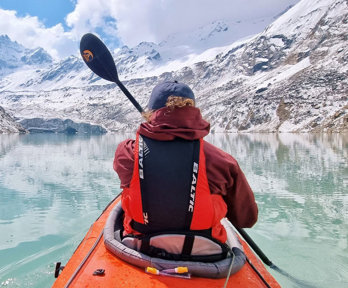
Field guides and publications
From 1854 to the present day, explore our rich heritage of guides and publications in support of geographical exploration.
We have a long tradition of publishing information and advice for those undertaking exploratory journeys and carrying out field research in remote and challenging environments around the world.
The pocket guidebook Hints to Travellers – perhaps the Victorian equivalent of a Lonely Planet guide – was first published by the Society in 1854, and Hints to Lady Travellers in 1889, followed by a variety of travel medicine publications. Specialist articles on field research techniques often appeared in the Society’s periodicals, including The Geographical Journal, and were later distributed as off-prints.
In the early 1980s, the Society’s Expedition Advisory Centre began to publish a series of logistics manuals for those exploring remote and challenging environments, followed in the 1990s by a series of field research manuals for expeditionary scientists undertaking biodiversity surveys and field mapping.
The Oxford Handbook of Expedition and Wilderness Medicine (Oxford University Press, 2023), derived from the RGS Expedition Medicine Manual (Profile Books, 2002), is now in its third edition and remains the authoritative work on the subject.
More recently, the much-respected RGS Expedition Handbook (Profile Books, 2004) – a direct descendant of Hints to Travellers and the Expedition Planners’ Handbook series – has been reimagined as a collection of digital resources in the RGS Explore Resource Hub.
The Society’s publishing tradition continues today in support of modern geographical exploration, with in-house publications available to order and download in print and digital formats.
Out-of-print titles are available to consult in the Foyle Reading Room, and those under contract to external publishers or endorsed by the Society via major booksellers and libraries.
In print titles
See more details and access print and digital editions of these titles by following the links below.
Reference books
- Oxford Handbook of Expedition and Wilderness Medicine (3rd Edition) – Edited by Sarah R. Anderson, Jon Dallimore, Chris Imray, Chris Johnson, James Moore and Shane Winser, published by Oxford University Press, 2023. 881pp. ISBN: 978-0-198867-01-2.
Biodiversity surveys
- Expedition Field Techniques: Camera Trapping (first edition) – Tim van Berkel, 2014. 122pp. ISBN: 978-0-907649-93-9.
- Expedition Field Techniques: Bats (first edition) – Kate Barlow, 1999. 73pp. ISBN: 978-0-907649-82-3.
- Expedition Field Techniques: Bird Surveys (first edition) – Colin Bibby, Martin Jones & Stuart Marsden, 1998. 139pp. ISBN: 978-0-907649-79-3.
- Expedition Field Techniques: Fishes (second edition) – Brian Coad, 1998. 107pp. ISBN: 978-0-907649-71-7.
- Expedition Field Techniques: Insects (first edition) – George McGavin, 1997. 96pp. ISBN: 978-0-907649-74-2.
- Expedition Field Techniques: Primates (first edition) – Adrian Barnett, 1995. 137pp. ISBN: 978-0-907649-69-4.
- Expedition Field Techniques: Reptiles & Amphibians (first edition) – Daniel Bennett, 1999. 94pp. ISBN: 978-0-907649-81-6.
- Expedition Field Techniques: Small Mammals (excl. bats) (second edition) – Adrian Barnett & John Dutton, 1995. 140pp. ISBN: 978-0-907649-68-7.
Out of print titles
Reference copies of out-of-print titles may be consulted in the Society’s Foyle Reading Room. Follow the links below to access their RGS Collections catalogue entries.
Reference books
- The Royal Geographical Society Expedition Handbook – Edited by Shane Winser, published by Profile Books, 2004. 502pp. ISBN: 1861970447 / 978-1-861970-44-2.
- The Royal Geographical Society Expedition Medicine Manual (2nd Edition) – Edited by David Warrell and Sarah Anderson, published by Profile Books, 2002. 398pp. ISBN: 1861974345.
- The Mountain Traveller’s Handbook – Paul Deegan, published by the British Mountaineering Council, 2002. 224pp. ISBN: 978-0-903908-47-4.
- Vehicle-dependent Expedition Guide (2nd Edition) – Tom Sheppard, published by Desert Winds, 2003. 544pp. ISBN: 0-9532324-1-7
- Blood, Sweat & Charity – Nick Stanhope, published by Eye Books, 2005. 230pp. ISBN: 978-1-903070-41-3.
- Mountaineering in the Andes: a sourcebook for climbers (2nd Edition) – Jill Neate, 1994. 256pp. ISBN: 0-907649-64-5.
- Reference Sources for Expeditions – Compiled by John Hemming, 1982. 39pp. ISBN: 0907649068.
Mapping, blogging and surveying
- Expedition Field Techniques: GIS, GPS and Remote Sensing – Richard Teeuw, Martin Whiteside, Nicholas McWilliam & Paul Zukowskyj, 2005. ISBN: 978-0-907649-88-5.
- Geoblogging for Travellers – Edited by Jamie Buchanan-Dunlop, 2009. ISBN: n/a.
- Field Guide to Humanitarian Mapping (2nd Edition) – Published by MapAction, 2011. ISBN: n/a.
Social research
- People-Oriented Research – Edited by Sachin Kapila & Fergus Lyon, 2006. 73pp. ISBN: 978-0-907649-67-0.
- Education Projects – Edited by Jen Hurst, 1998. 76pp. ISBN: 978-0-907649-78-6.
Logistics manuals
- Bicycle Expeditions (1st Edition) – Paul Vickers, 1990. 42pp. ISBN: 978-0-907649-45-8.
- Polar Expeditions (4th Edition) – Edited by Rachel Duncan, 2003. 120pp. ISBN: 0-907649-91-2.
- Caving Expeditions (3rd Edition) – Edited by Dick Willis, jointly published by BCRA, 1993. 186pp. ISBN: 978-0-907649-62-5.
- Desert Expeditions (3rd Edition) – Tom Sheppard, 1988. 86pp. ISBN: 978-0-907649-15-1.
- Tropical Forest Expeditions (5th Edition) – Edited by Clive Jermy & Roger Chapman, 2002. 198pp. ISBN: 978-0-907649-84-7.
- Underwater Expeditions (3rd Edition) – Edited by Rob Palmer, 1990. 112pp. ISBN: 978-0-907649-31-1.


